 This article on Rhodesian Ridgebacks is part of a series to highlight the Big Picture of health, welfare and breeding and to help develop Globally Relevant Integrated Health Profiles (GRIHPs) for many breeds. See IPFD's Get a GRIHP! on Breed Health Initiative
This article on Rhodesian Ridgebacks is part of a series to highlight the Big Picture of health, welfare and breeding and to help develop Globally Relevant Integrated Health Profiles (GRIHPs) for many breeds. See IPFD's Get a GRIHP! on Breed Health Initiative
There are many others doing great work to advance heath, well-being, and welfare in this wonderful breed. We reference and link to terrific work, developments, reports, and research from the UK, USA, Sweden, Finland and more below. Thanks to all of those working on behalf of Ridgebacks.
This is a 'living document' - so if anyone has more material to share or point us to - please let us know!
Table of Contents
Breed At a Glance - Rhodesian Ridgeback
Rhodesian Ridgebacks are versatile hobby and companion dogs which are also used for hunting. The breed is alert, intelligent and athletic. The Ridgeback is an excellent natural watchdog and family protector. These dogs do best with a knowledgeable dog owner who is willing to train and socialize to assure stability and reliability.
Key Health Conditions - The Basics: Rhodesian Ridgeback
 CONTEXT: the list of key health conditions is based on a review of educational content and data available from, e.g., IPFD’s Kennel Club Partners and Rhodesian Ridgeback breed club websites; Agria Sweden pet insurance data and breed profiles; other veterinary practice data; and peer reviewed research. The health conditions are identified by experts, breed-health advisors, owners, and available evidence as those affecting health, quality of life, and welfare for affected individual dogs and/or creating issues and management challenges at a breed level. Key health conditions listed do not represent all health challenges in a breed but are generally recognized as occurring or emerging in the breed; most are important to consider in breeding decisions. This section highlights key conditions - details, further data and more information, breed-specific programs for various conditions, the international breed population - and more - follows further below.
CONTEXT: the list of key health conditions is based on a review of educational content and data available from, e.g., IPFD’s Kennel Club Partners and Rhodesian Ridgeback breed club websites; Agria Sweden pet insurance data and breed profiles; other veterinary practice data; and peer reviewed research. The health conditions are identified by experts, breed-health advisors, owners, and available evidence as those affecting health, quality of life, and welfare for affected individual dogs and/or creating issues and management challenges at a breed level. Key health conditions listed do not represent all health challenges in a breed but are generally recognized as occurring or emerging in the breed; most are important to consider in breeding decisions. This section highlights key conditions - details, further data and more information, breed-specific programs for various conditions, the international breed population - and more - follows further below.
Rhodesian dogs are affected by immunological diseases, of which allergies, atopy, hypothyroidism, and tumors are the most common.
Orthopedics: Hip (HD) and elbow dysplasia (ED) occur, usually mild grades.
Other musculoskeletal health risks include lumbosacral transitional vertebra (LTV) and spondylosis, as well as shoulder and hock osteochondrosis.
Reproductive System: Prostate and anal infections are not uncommon, as are uterine infections in aging bitches.
Eye Disease: the most common conditions reported are distichiasis, uvea defects and cataracts - eye exams are recommended/required for a CHIC number by the US Breed Club. See the Bluebook at OFA for statistics.
Hereditary Defect: Dermoid Sinus: It is estimated 3-4 % of Rhodesian Ridgebacks are born with dermoid sinus, a malformation of the skin, which is related to the ridge. It is recommended that owners have a knowledgeable breeder or veterinarian check the puppy or adult dog for a Dermoid. Risk: Dermoids, can result in chronic abscesses and infections (chronic abscesses, mean the dog is likely to be in a lot of discomfort). Dermoids connected to the spinal cord could cause meningitis, encephalitis or myelitis which could lead to the death of the dog through infection. Dermoids can be surgically removed. Not everyone knows what dermoids are, not every breeder has seen or felt one and not every veterinarian has seen this defect in their practice. An individual who has or has had surgery for DS should never be used in breeding.
Juvenile Myclonic Epilepsy (JME) in Rhodesian Ridgebacks is an inherited defect only in Rhodesian Ridgebacks that affects young dogs <18 months. Symptoms include frequent twitches and myoclonic muscle jerks usually when the dog is sleeping or resting; dogs may develop Grand Mal seizures. Carrier rate is estimated by the UK breed club at 15%.
What do Caretakers of Rhodesian Ridgebacks need to Know?
 Character Development: The breed has guard and hunting instincts. Dogs are also relatively independent and some individuals show more fears than are desirable. This mix of mental characteristics makes the Rhodesian Ridgeback a demanding breed to handle - the owner needs to have experience working with dogs. The breed generally serves well as a family dog and loves his family, but usually will pick a favorite. Dogs should be disinterested in strangers. (See Mentality evaluations information below.)
Character Development: The breed has guard and hunting instincts. Dogs are also relatively independent and some individuals show more fears than are desirable. This mix of mental characteristics makes the Rhodesian Ridgeback a demanding breed to handle - the owner needs to have experience working with dogs. The breed generally serves well as a family dog and loves his family, but usually will pick a favorite. Dogs should be disinterested in strangers. (See Mentality evaluations information below.)
A Rhodesian Ridgeback is known to be very active and intense as a puppy and young dog. Anyone who is considering acquiring the breed should understand that these dogs also need a lot of environmental and social training as a puppy / young dog. Caretakers should be prepared to attend obedience courses during the dog's first 1-2 years.
Fitness: Diet: The breed loves to eat! See the Rhodesian Ridgeback Club of the United States' flyer: Fit or Fat. Excess weight / weight gain despite a reasonable diet may be a symptom of Hypothyroidism - which is not uncommon in Ridgebacks.
Statistics and Health Strategies
CONTEXT: We are pleased to be able to highlight a selection of internationally based Health Strategy Providers who offer content-rich statistics and in-depth, up-to-date information on health issues along with health strategies conceived to improve management of health and welfare for many breeds.
The websites for the Rhodesian Ridgeback Club of USA, Sweden's Specialklubben Rhodesian Ridgeback Sverige (SRRS) and the Finnish club, Suomen Ridgeback- yhdistys ry offer exceptional access to expansive breed-specific advice and health articles to aid buyers, owners and breeders. Each Rhodesian Ridgeback Club's website offers value-added breed information. See the Breeding Strategies section below for further international information.
Population

The AKC ranked Rhodesian Ridgebacks at 42nd out of 195 breeds in 2020; the breed's ranking has remained somewhat steady between 2014 and 2020 ranging from 39th - 42nd. Registration statistics are made available to the AKC's parent clubs on request. Approximately 2000 Rhodesian Ridgebacks are registered annually with AKC. (Source: https://www.ridgebackrescue.org/breedinfo/RRCUS_before_you_buy_a_ridgeback.html)
Please note KC registered dogs do not necessarily represent all Rhodesian Ridgebacks living in the countries shown.
Health and longevity statistics
Agria - Swedish Breed Profiles
CONTEXT: For many years, Agria Animal Insurance, Sweden (Agria Djurförsäkring, Stockholm, Sweden) has supported veterinary research and provided statistics on diagnoses for health and life claims to Swedish breed clubs. See Breeds with Swedish Insurance Data and Agria Breed Profiles (where breeds are compared to All Breeds). ! We recommend that you download the Agria Breed Profiles for the Bernese Mountain Dog and study them for full available information. Some excerpts are shown below! The great benefits of the Swedish insurance data are that they include almost 40% of the national population of dogs, so are very representative; note that animals at very old ages are likely under-represented. Most importantly, information is available on all insured dogs, not simply those who get sick or die.
This allows calculation of population-based rates (expressed a events per 10,000 years-at-risk) as well as risks and proportions. Statistics are presented as overall morbidity (rate of one or more veterinary care events [VCE]) or mortality (death), by general diagnostic categories, and by specific diagnoses.
Agria Breed profiles for Rhodesian Ridgebacks are available:
Extracts from Veterinary Care Events Agria 2011-2016
Relative Risk Morbidity of Rhodesian Ridgeback compared to All Breeds: 1.29




Extracts from Agria Breed Profile (Life) 2011-2016
Mortality - Relative Risk Mortality of Rhodesian Ridgeback compared to All Breeds: 1.07

Notes: Lymphoma as well as leukemia, skeletal cancer and tumors of the lung and liver among the most common causes of death related to tumors of the Rhodesian Ridgeback before ten years of age.

Notes: The most common causes of euthanasia before ten years of age are lymphoma, accidents, epilepsy, allergy / atopy and skin problems. The risk of death before the age of ten is not higher than in all dogs.
Mortality comparison cancer/neoplasia. Ridgebacks have moderate risk, less than some known cancer breeds, and at a reasonably high median age at death:

Finland: Rhodesian Ridgeback Mortality Data
Finland: tumor diseases and cancer are by far the leading causes of death in Finnish Rhodes ian Ridgebacks. The average life expectancy according to the table on the right is 9 years 7 months. Young dogs also die to some extent, and in these cases most often it is autoimmune diseases or cancer and tumor diseases. The Finnish Breed Club considers it particularly important that a dog that dies, especially at a young age (under 6 years), undergoes an necropsy and that the cause of death of the dog is determined.
ian Ridgebacks. The average life expectancy according to the table on the right is 9 years 7 months. Young dogs also die to some extent, and in these cases most often it is autoimmune diseases or cancer and tumor diseases. The Finnish Breed Club considers it particularly important that a dog that dies, especially at a young age (under 6 years), undergoes an necropsy and that the cause of death of the dog is determined.
Longevity and causes of death in Finland - 2011-2021 (Finnish Kennel Club breeding database): Worth noting: that although deaths due to cancer are high, the average age at death is relatively high (compared to some other high cancer breeds).

Breed Specific Breeding Strategies

Comment: Rhodesian Ridgeback Clubs worldwide support and encourage caretakers to train and socialize their dogs. These active athletic dogs benefit from participation in performance events such as Agility, Lure Coursing, Tracking, Nosework and Rally.
Evaluating Mental traits - Nordic Countries
In the Nordic countries, mental description (Mentalbeskrivning Hund, MH) is widely used to characterize the mental traits of the dogs. Another tool widely used to describe the character of dogs in Sweden is BPH (Beteende- och personlighetsbeskrivning hund - see the video in the link).
hund - see the video in the link).
The Swedish RAS and the Finnish JTO include graphs showing the average reactions of dogs for different situations in the descriptions. See an explanation of the BPH in English. The results for various behavior variables are summarized both in tabular and graphic form. The same behavior is measured in several situations and the presented results are a summarized result. In the graph the individual dog’s behavior is compared with the breed average.
The breed clubs recommend that breeding dogs have an approved mental description done and that dogs showing unwanted behavior (sound sensitivity, aggressiveness, poor resilience and timidity) would not be used for breeding.
See the gragh for average values of different parts of MH in Swedish Rhodesian Ridgebacks.
Also See: 500–analys Beteende- och personlighetsbeskrivning hund BPH
Sweden: New in August of 2022 the Rhodesian ridgeback is the first with MI - SPECIALKLUBBEN RHODESIAN RIDGEBACK SVERIGE: MENTALINDEX för rhodesian ridgeback baserat på BPH
Read more on MI, based on BPH - which provides a statistical measure, a calculated value, of a dog's expected heritability for a number of different traits.
Health Screening Tests for the Rhodesian Ridgeback
Summary: Hip Dysplasia, Elbow Dysplasia, Spine, OCD, Dermoid Sinus, Eye disease, Epilepsy, Generalized Myoclonic, with Photosensitivity (JME), Thyroid tests and Heart tests are done. Testing recommendations/requirements vary from country to country. (See table below.)
See below for further information on conditions and breeding strategies by country.
More Info
FINLAND
Spine - Lumbosacral transitional vertebra (LTV) and spondylosis
Finland: spine x-rays are mandatory for breeding dogs, in order to get the litter registered by the kennel club. See the Finnish Kennel Club instructions for spinal radiography here. For LTV, minimum screening age is 12 and for spondylosis, 24 months.
-
Almost 40% of the screened dogs have varying degrees of LTV changes: LTV1 18.9 %, LTV2 3.7 %, LTV3 4.9 %, LTV4 12.2 %. Recommendation of the Finnish breed club: all asymptomatic dogs can be used for breeding, but dogs with a grade 1 to 4 should be combined only with dogs with a grade 0 (no changes).
-
Spondylosis: 97 % free/mild (0/1); 41 % screened. Recommendation of the Finnish breed club: when using a dog with spondylosis for breeding, efforts should be made to find a partner that is free of spondylosis (SP0).
Hip dysplasia
Finland:  hip dysplasia screening is mandatory for breeding dogs, in order to get the litter registered by the kennel club. Minimum age for screening is 18 months. Grade C (mild dysplasia) is allowed, but only if the mating partner has grade A (normal). Frequencies in Finland: 91 % healthy/borderline (A/B); 51 % screened.
hip dysplasia screening is mandatory for breeding dogs, in order to get the litter registered by the kennel club. Minimum age for screening is 18 months. Grade C (mild dysplasia) is allowed, but only if the mating partner has grade A (normal). Frequencies in Finland: 91 % healthy/borderline (A/B); 51 % screened.
Elbow dysplasia
Finland:  Elbow dysplasia screening mandatory for breeding dogs, in order to get the litter registered by the kennel club. Finland: minimum age for screening is 18 months. Grades 0-1 are allowed, but grade 1 only if the mating partner has grade 0. Finland: 90 % healthy/borderline (0); 51 % screened.
Elbow dysplasia screening mandatory for breeding dogs, in order to get the litter registered by the kennel club. Finland: minimum age for screening is 18 months. Grades 0-1 are allowed, but grade 1 only if the mating partner has grade 0. Finland: 90 % healthy/borderline (0); 51 % screened.
Osteochondrosis
A Health survey conducted by the Finnish breed club, indicated osteochondrosis had occurred in 12 % of dogs. Read Finnish Kennel Club's new guidelines for screening and grading of shoulder osteochondrosis.
Immunological problems
Tumors/cancer: Finnish breed club's survey 2015: 18 % had or had had a tumor or cancer diagnosed by a veterinarian. Most common: mammalian tumors (35 %), mast cell cancer (22 %) and lymphoma (17 %). In addition, 17 % had some unspecified cancer.
Autoimmune diseases: frequency in Finland 10 % (Breed Club's survey 2015).
Hypothyroidism
In Finland 5 % of the dogs tested as hypothyroid (Breed Club's survey 2015).
Earlobe rupture / cracking (inflammation of the blood vessels i.e., vasculitis): 15 % of the dogs (Breed Club's survey 2015).
Atopy and allergy: recurrent infections are often associated with canine allergies and atopy. Recurrent otitis is one of the most typical symptoms of atopy. Finland: 36 % of the dogs had had 3 or more infections and 6% of the dogs had chronic inflammation that requires constant treatment (Breed Club survey 2015).
-
A dog with recurrent infections should never be used for breeding. This also applies to dogs which are asymptomatic due to treatment or feed change (Swedish and Finnish Breed Clubs).
-
A dog with a skin infection in the past, but now asymptomatic for a significant time without a feed change or continuous treatment, can be used for breeding with a partner who has never exhibited clinical symptoms of skin-related ailments (Swedish Breed Club).
Finland, health survey 2015:
-
20 % of dogs had atopy or allergies.
-
65 % had had various infections. The most common infections were ear (33 %), eye (16 %), skin infections (13 %), urinary tract (11 %), anal gland (8 %), prostate (5 %).
More Info
SWEDEN
Spine -  Lumbosacral transitional vertebra (LTV) and spondylosis
Lumbosacral transitional vertebra (LTV) and spondylosis
In Sweden, the Breed Club gathers information on spine-related diagnoses yearly in 3- (first graph) as well as 8-year-old (second graph) dogs (Disk bråck nacke = disc hernia, nacke = neck, bröst = thoracic, länd = lumbar):
Hip Dysplasia
Sweden (and Norway): the breed clubs' puppy referral rules require screening and the status A or B (normal or borderline) in order for the litter to be allowed in the list/reference. Sweden (Födelseår = Birth year, C = mild hip dysplasia, D = moderate, E = severe, Medel = Average)
(and Norway): the breed clubs' puppy referral rules require screening and the status A or B (normal or borderline) in order for the litter to be allowed in the list/reference. Sweden (Födelseår = Birth year, C = mild hip dysplasia, D = moderate, E = severe, Medel = Average)
Elbow Dysplasia
Sweden (and Finland): Elbow dysplasia screening mandatory for breeding dogs, in order to get the litter registered by the kennel club.  Frequencies in Sweden
Frequencies in Sweden
(Födelseår = Birth year, 1 = mild, 2 = moderate, 3 = severe arthrosis, Medel = Average):
Hypothyroidism
Sweden: yearly reported number of dogs varies between 0-9
Sweden (Breed club info on RAS; hälsoenkät = health survey; 3 år = 3 year old dogs; avelsregister = breeding register):

Dermoid Sinus
The Ridge on the back of the Rhodesian Ridgeback is the hallmark of the breed, but unfortunately the genes for the ridge can also cause the congenital neural tube defect known as dermoid sinus ( Duplication of FGF3, FGF4, FGF19 and ORAOV1 causes hair ridge and predisposition to dermoid sinus in Ridgeback dogs., Hillbertz N, Nature genetics,2007 vol: 39 (11) pp: 1318-1320) . However, as the Nature Genetics article title indicates, the ridgegene only causes predisposition to dermoid sinus.
5-6 % and 8-10 % of the Swedish population of Rhodesian Ridgebacks were affected in two studies by Salmon Hillbertz in 2006. In 2016, the percentage of DS puppies had fallen from 4.5 % in 2005 to less than 1.5 % (material from several breed clubs; see the follow up report of the breed's world congress). Currently in Swede and Finland, 3-4 % of puppies have DS.
Reported cases of DS in Sweden as a proportion of all puppies and litters born (Hundar = Dogs, Kullar = Litters, Födelseår = Birth year, Andel = Proportion):

Atopy-Allergies


Sweden: the proportion of 3-year-old dogs (by birth year) with skin problems seems to be decreasing, but allergies stay at 13-14 %. Survey by the Swedish Breed Club (Hudbesvär = skin problems, Andel = proportion):
-
A dog with recurrent infections should never be used for breeding. This also applies to dogs which are asymptomatic due to treatment or feed change (Swedish and Finnish Breed Clubs).
-
A dog with a skin infection in the past, but now asymptomatic for a significant time without a feed change or continuous treatment, can be used for breeding with a partner who has never exhibited clinical symptoms of skin-related ailments (Swedish Breed Club).
More Info
NORWAY
Hip Dysplasia
Norway:  the breed club's puppy referral rules requires screening and the status A or B (normal or borderline) in order for the litter to be allowed in the list/reference.
the breed club's puppy referral rules requires screening and the status A or B (normal or borderline) in order for the litter to be allowed in the list/reference.
Charts for HD & ED via Norwegian Kennel Club, Dogweb:
Elbow Dysplasia
Norway: the breed club's puppy referral rules require that the status is 0 (healthy/borderline) in order for the litter to be allowed in the list/reference.
the breed club's puppy referral rules require that the status is 0 (healthy/borderline) in order for the litter to be allowed in the list/reference.
More Info
UNITED STATES
Health Strategies and Health Surveys (OFA & Breed Club)
The Rhodesian Ridgeback Club of the United States:
Rhodesian Ridgeback Charitable Foundation:
OFA-CHIC Health Testing Requirements for Rhodesian Ridgebacks
"The OFA, working with the breed's parent club, recommends the following basic health screening tests for all breeding stock. Dogs meeting these basic health screening requirements will be issued Canine Health Information Center (CHIC) numbers. For CHIC certification, all results do not need to be normal, but they must all be in the public domain so that responsible breeders can make more informed breeding decisions. For potential puppy buyers, CHIC certification is a good indicator the breeder responsibly factors good health into their selection criteria. The breed specific list below represents the basic health screening recommendations. It is not all encompassing. There may be other health screening tests appropriate for this breed. And, there may be other health concerns for which there is no commonly accepted screening protocol available."
See: https://www.ofa.org/recommended-tests?breed=RR
Hip Dysplasia (One of the following)
OFA Evaluation
PennHIP Evaluation (min age 12 months)
Elbow Dysplasia
OFA Evaluation
Eye Examination. Exams are recommended annually to age 9, annual recertifcation is required
Eye Examination by a boarded ACVO Ophthalmologist
Autoimmune thyroiditis
OFA evaluation from an approved laboratory or report from board certified endocrinologist or pathologist - OFA Thyroid exams are recommended at age 2, 3, 4, 5, 6 and 8.
Cardiac Evaluation (Optional but recommended)
Congenital Cardiac Exam
Advanced Cardiac Exam
Basic Cardiac Exam
Congenital Deafness (Optional but recommended)
OFA evaluation based on BAER test (min age 12 months)
GDC evaluation based on BAER test (min age 12 months)
Results of screening for the above conditions are available: https://www.ofa.org/diseases/breed-statistics & in the Breed Summary Report - https://secure.ofa.org/regSums/RHODESIAN RIDGEBACK.pdf
Eye screening results: ACVO Blue Book - Rhodesian Ridgebacks
Thyroid: See: Lymphocytic Thyroiditis - It's Not Just Hypothyroidism, By Cynthia Roethel
Heart - Research Studies/DNA Test
PLEASE NOTE:
Information on the arrhythmias and sudden cardiac death in RRs. (Family-Specific- investigation ongoing); research notes: cvm.ncsu.edu - AKC CHF Grants funded by the US Breed Club.
Rhodesian Ridgeback Inherited Arrhythmia (RR IVA) is an inherited disease that results in an abnormality of the cardiac electrical system leading to the development of abnormal heart beats (ventricular premature beats (VPCs).
2 studies
https://www.ncbi.nlm.nih.gov/pmc/articles/PMC4871594/
https://www.ncbi.nlm.nih.gov/pmc/articles/PMC6409531/#B8-genes-10-00168
AKC-CHF grants - researcher reports...
http://rrcfus.org/pdf/AKC_CHF_2389-MOU_EY1_Summary.pdf
http://rrcfus.org/pdf/Report_March_2018.pdf
RESEARCH PROGRESS REPORT SUMMARY - rrcfus.org
NC State Veterinary Hospital: Small Animal: Veterinary Genetics - Rhodesian Ridgeback Inherited Ventricular Arrhythmia Screening - NC State Veterinary Medicine. A genetic test can be performed to determine if your dog has the DNA mutation that will put him/her at risk for the disease...https://cvm.ncsu.edu/nc-state-vet-hospital/small-animal/genetics/submit-dna-testing/nc-state-veterinary-hospital-small-animal-veterinary-genetics-cardiac-health/rhodesian-ridgeback-inherited-ventricular-arrhythmia-screening/
OFA reports for a few tests...
More Info
UK (The Kennel Club)
Priority health schemes and tests
The Kennel Club's Assured Breeders must use the following (or equivalent) schemes, tests and advice. All other breeders are strongly advised to also use these.
Important health schemes and tests
The Kennel Club strongly recommends that all breeders, both assured breeders (ABs) and non ABs, use the following (or equivalent) schemes, tests and advice.
Other considerations - breeding dogs: Reproduction
 Reproduction is usually unproblematic. Recommended minimum age at mating:
Reproduction is usually unproblematic. Recommended minimum age at mating:
-
Swedish & Norwegian Breed Clubs: 30 months
-
Finnish Breed Club: 24 months
From the Swedish RAS: Approximately 80 % of whelpings normal (Valpning =Whelping, Födelseår = Birth year, Andel = Proportion, Komplikationer = Complications, Kejsarsnitt = Caesarian section).
HGTD DNA Tests for Rhodesian Ridgebacks
The Harmonization of Genetic Testing for Dogs (HGTD) Basics: - The HGTD Searchable Database - Search by Breed, Search by Disease / Test and Search by Genetic Test Provider (GTP) / Lab + Genetic Counselling Resources. HGTD catalogs information provided voluntarily from genetic test providers (GTPs) including information on their company and services, quality measures and expertise, tests offered and more. As of January 2021, the HGTD Database includes 82 academic and commercial genetic test providers (GTPs) in 22 countries. Our searchable genetic phenes (phenes = characteristics/genetically controlled feature) database currently holds information on 300+ phenes across all breeds/types and provides information on each phene: links to the Online Mendelian Inheritance in Animals database (OMIA), gene + mutations, a simple and advanced disease description, inheritance details, links to original publications, patents/licenses, comments from the original researchers/experts on application, and breed specific information (such as research/validation) - where possible. Breed Relevance Ratings (BRR) support evidence-based usage and application of genetic tests. The HGTD database relevance rating indicates the level of available evidence supporting the application of a specific genetic test for a specific breed/type. Currently, the relevance rating is based on a wide variety of evidence sources. This includes peer-reviewed research papers, recommendations from the original researchers/test developers, input from additional experts including veterinary specialists, and breed experts. It is hoped that, by being more informative about what we currently know or do not know about a specific test for a specific breed, that dog health advisors and owners can make more informed decisions. Remember, this Breed Relevance Rating is not everything we need to know about the disease or characteristic; it is focused on the genetic test.
♦ BIG PICTURE THINKING ♦ Please take into consideration - Most of the owner and breeder reported inherited or likely inherited disease concerns of the breed do not currently have genetic tests. See the HGTD for a full list of DNA tests including "Trait" and "Parentage" tests.
9-1-2021 HGTD Tests
-
Epilepsy, Generalized Myoclonic, with Photosensitivity (JME)
-
Notes: frequency of affecteds 5 % and carriers 15 %. Autosomal recessive.
-
Factor IX Deficiency
-
Degenerative Myelopathy (DM):
-
Notes: Swedish and Finnish breed clubs: the test is not generally recommended, since there are so few sick dogs. Very few cases in Norway as well. Test usage is widespread in the USA, despite few suspected cases globally, and the increasing use of foreign breeding animals has led to more and more breeders choosing to retest their breeding animals. Carriers can, and should, be used in breeding plans with individuals that have been tested risk-free of the condition.
Other DNA Tests
-
Ridge (dermoid sinus): Genetic testing available at least in the Czech Republic with GenoCan.
-
Notes: The ridge is not always visible and Rr dogs may appear as rr.
-
Early Onset Adult Deafness (EOAD) - autosomal recessive, dna-test at a pilot stage.
-
Notes: Finland: no affected dogs.
Conditions/Health Tests and Health Strategy Provider Recognition Status
|
Hip Dysplasia
|
All clubs acknowledge, recommend or require this screening
|
|
Elbow Dyplasia
|
All clubs acknowledge, recommend or require this screening
|
|
Spine
|
Mandatory screening in Finland - for breeding dogs (LVT / Spondylosis)
|
|
Dermoid Sinus
|
All clubs acknowledge the condition - evaluation by an experienced party is recommend. Vets may not have seen this condition
|
|
Thyroid
|
All clubs acknowledge, recommend or require this screening
|
|
Heart
|
Some clubs acknowledge, recommend or require this screening, The US club in particular.
|
|
Eye Exam
|
Some clubs acknowledge, recommend or require this screening, The US club in particular.
|
|
Epilepsy (JME)
|
All clubs acknowledge, recommend or require this DNA test
|
|
Degenerative Myelopathy
|
Some clubs mention the DM DNA Risk test
|
|
Allergies / Immune conditions
|
All clubs acknowledge Allergies and Immune conditions, including cancers impact some dogs in the Ridgeback breed
|
Genetic Diversity in the Rhodesian Ridgebacks - Research & Reports
 The Nordic breed clubs are careful to keep the inbreeding rate low to maintain health. In MyDogDNA analyses, the amount of genetic variation in the breed seems to be at a little higher level compared to other analyzed breeds.
The Nordic breed clubs are careful to keep the inbreeding rate low to maintain health. In MyDogDNA analyses, the amount of genetic variation in the breed seems to be at a little higher level compared to other analyzed breeds.
Finland: Only a small number of dogs are being used for breeding, effective population size is small. This contributes to the increase in immunological diseases.
Maximum recommended number of offspring per individual dog:
-
Sweden: 40 offspring and 80 second-generation offspring.
-
Norway: 38 offspring - females altogether, males in a 5-year-period.
-
Finland: 3 litters. However, the dog may, for justified reasons, be used for breeding after that, as long as there is evidence in the offspring that the dog inherits healthy, typical for the breed offspring with a good character.
Average inbreeding coefficients:
-
Sweden: The inbreeding coefficient of a litter should not exceed the average value for the breed, i.e. 1 %, calculated over five generations. Litters with a higher coefficient than 1 % should only occur in exceptional cases, and then not exceed 6.25 %, calculated on five generations. This is the limit for the litter to be included in the Breed Club's puppy referral.
-
The average inbreeding coefficient in Finland seems small, because mainly foreign dogs are used for breeding. Recommendation of the Breed Club is to keep the maximum five-generation inbreeding coefficients of litters at 6.25 %.
Average 5-generation inbreeding coefficient (COI) has decreased in Sweden (Swedish Kennel Club Aveldata and Swedish RAS; födelseår = birth year):

Litters per dog in Sweden (Medelvärde = Average, Avkommornas födelseår = Birth year of the offspring, Avelshanar = Breeding males, Avelstikar = Breeding females; Swedish RAS):

The Flawed ridge is a major factor affecting the size of the gene pool!
Finland and Sweden: every tenth dog is ridgeless and approximately 13 % have flawed ridge. Different countries have different practices and cultures for these puppies: sometimes these puppies are still put down. Finland: puppies are mostly being registered in the Not for breeding (EJ) -register and sold as pet dogs.
-
Swedish breed club: a dog that is ridgeless or has a flawed ridge (opposite the breed standard), should not be used in breeding.
-
Finnish breed club: breeders may, at his/her discretion, register the puppy to the normal FI-register. Such dog can be used for breeding if it otherwise meets the recommendations and requirements. In addition, the Finnish breed club's breeding committee and a breed judge have to inspect the dog, and the dog has to be tested or described with a mental test.
-> Issues related to the correct/incorrect ridge result in 20 % of the population removed from breeding.
A DNA test to identify hetero- (Rr) or homozygous (RR) ridge mutation in a ridged dog could be used to allow for the use of ridgeless dogs in breeding: mating between a ridgeless dog (rr) and a homozygous (RR) dog would produce only ridged individuals. Easing breeding requirements for ridge would increase the genetic diversity of the breed and possibly decrease the frequency of immunological problems. Breeding policies allowing ridgeless dogs in breeding would require wider international agreement among the breed enthusiastics.
History
The Rhodesian Ridgeback is a large-sized dog breed bred in the Southern Africa region. Its forebears can be traced to the ridged hunting and guarding dogs of the Khoikhoi, which were crossed with European dogs by the early colonists of the Cape Colony of southern Africa.
Source: Wikipedia
Also see the Rhodesian Ridgeback page at Native Breeds.org for a summary of breed development.
References and Resources
Finnish Breed Club: health: https://www.ridgeback.fi/22
Finnish JTO: https://jalostus.kennelliitto.fi/RotuPDF.ashx?R=146&T=2
Finnish Kennel Club’s breeding database (in English): https://jalostus.kennelliitto.fi/frmEtusivu.aspx?Lang=en&R=190
Finnish Kennel Club instructions for spinal radiography: https://www.kennelliitto.fi/en/forms/instructions-spinal-radiography
Norwegian Kennel Club’s breeding database Dogweb: https://www.dogweb.no/dogweb/dw/openPage/hoved.html
Salmon Hillbertz 2006 Inheritance of dermoid sinus in the Rhodesian ridgeback. doi.org/10.1111/j.1748-5827.2005.tb00295.x
Autosomal dominant mutation causing the dorsal ridge predisposes for dermoid sinus in Rhodesian ridgeback dogs. N. H. C. SALMON HILLBERTZ AND G. ANDERSSON. Journal of Small Animal Practice (2006) 47, 184–188 (Internal)10.1.1.657.459.pdf
Swedish Breed Club: https://srrs.org/srrs/avel
Swedish Kennel Club’s breeding database Avelsdata (in Swedish): https://hundar.skk.se/avelsdata/Initial.aspx
Swedish RAS: https://srrs.org/sites/default/files/documents/srrs_ras_v2_2018.pdf; updated statistics: https://srrs.org/sites/default/files/documents/srrs_ras_uppfoljning_2018-2022.pdf
UFAW: https://www.ufaw.org.uk/dogs/rhodesian-ridgeback-dermoid-sinus
DogWellNet Resources
DWN's Pedigreed Dogs Database: Rhodesian Ridgeback
HGTD - Rhodesian Ridgeback
Illustrated Standards-Study Guides/Compendiums
F.C.I.'s The Rhodesian Ridgeback - The National Dog Club of South Africa
The Rhodesian Ridgeback Illustrated Standard (AKC): The Rhodesian Ridgeback Club of the United States
Midlands & Northern Rhodesian Ridgeback Club
YOU BE THE JUDGE By Robert Cole From Dogs in Canada, August 1992 THE RHODESIAN RIDGEBACK
(Internal) rhodesianridgeback.pdf
IPFD and The World Small Animal Veterinary Association
See our series of Meet the Breed articles in the WSAVA Bulletin and associated Get a GRIHP! Articles on DogWellNet.com:
-
Welsh Corgi
-
Dachshund
-
French Bulldog
-
Australian Shepherd


-
Saluki
-
Golden Retriever
-
Bernese Mountain Dog
-
Black Russian Terrier
-
Pug
-
Finnish Spitz
-
Rhodesian Ridgeback
-
Rottweiler
-
Whippet
-
Belgian Shepherd
-
English Bulldog
-
Irish Soft Coated Wheaten Terrier
-
Dalmatian
-
Border Terrier
-
Staffordshire Bull Terrier
-
Siberian Husky
-
Dobermann
-
Shih Tzu
-
English Setter
-
Beagle
-
Chihuahua

 This article on Rhodesian Ridgebacks is part of a series to highlight the Big Picture of health, welfare and breeding and to help develop Globally Relevant Integrated Health Profiles (GRIHPs) for many breeds. See IPFD's Get a GRIHP! on Breed Health Initiative
This article on Rhodesian Ridgebacks is part of a series to highlight the Big Picture of health, welfare and breeding and to help develop Globally Relevant Integrated Health Profiles (GRIHPs) for many breeds. See IPFD's Get a GRIHP! on Breed Health Initiative
 Donate
Donate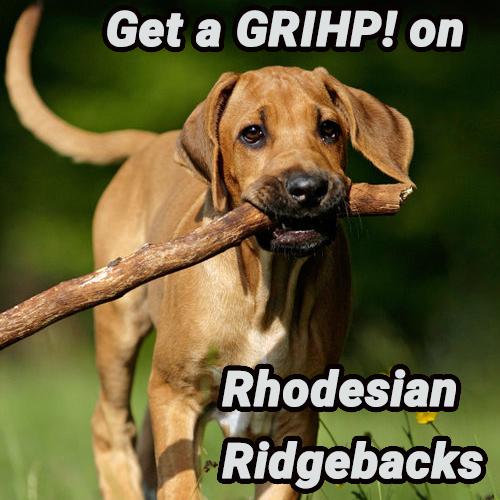
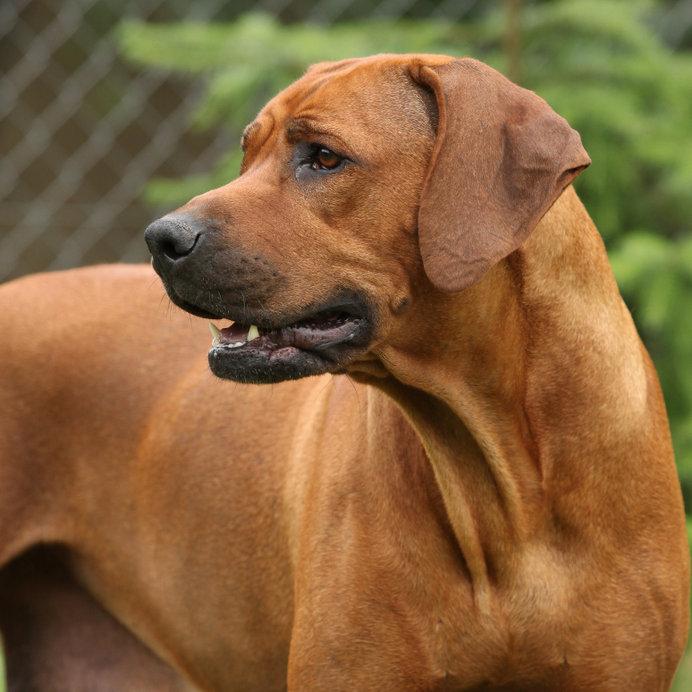
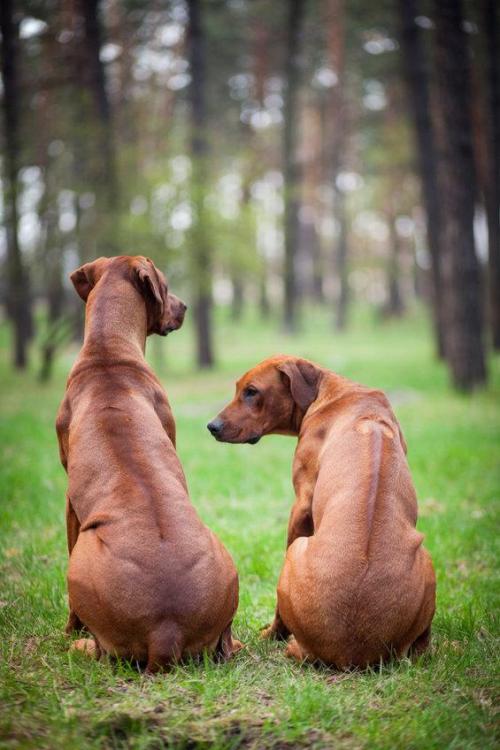

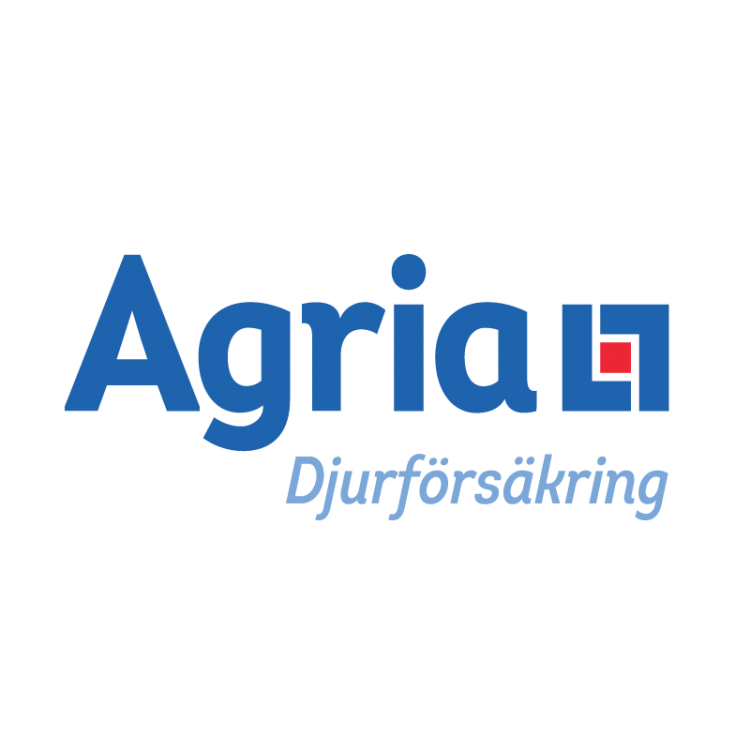
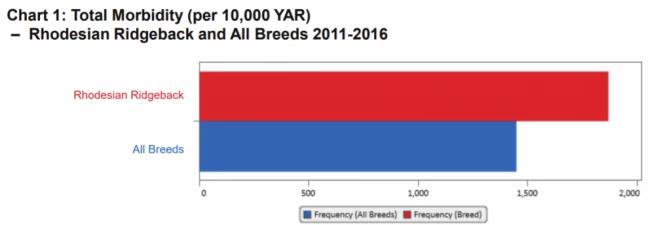
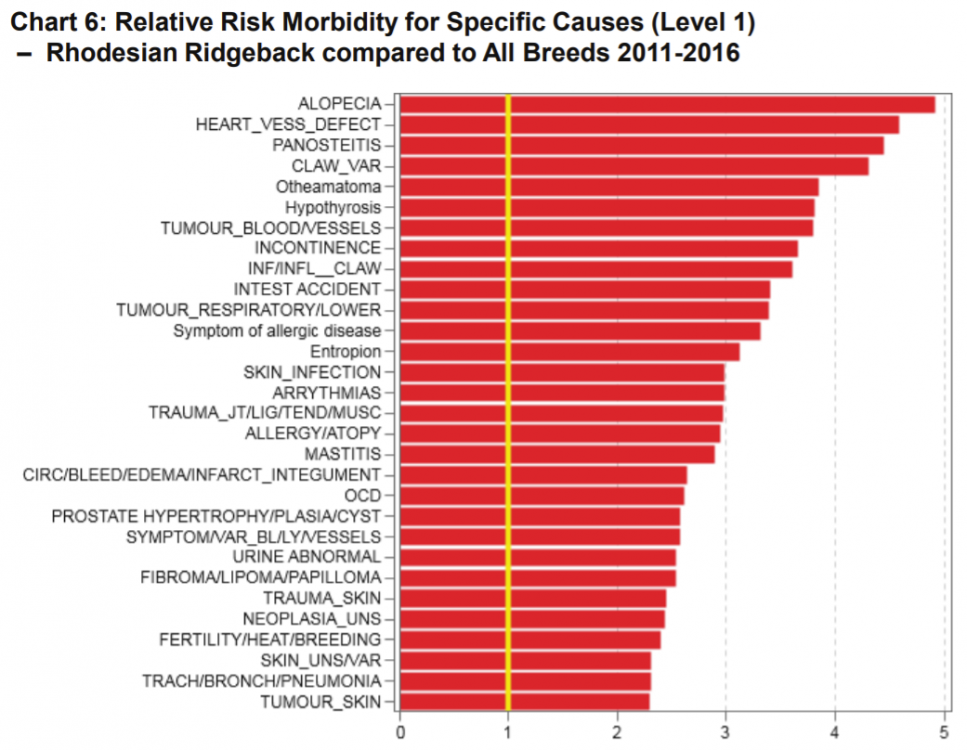
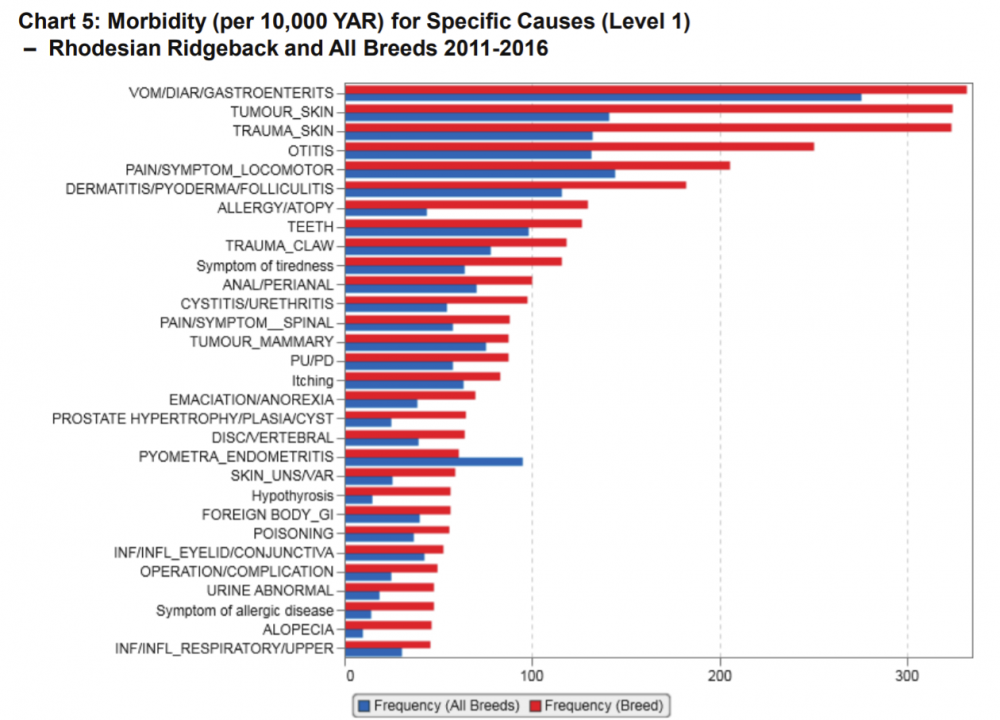


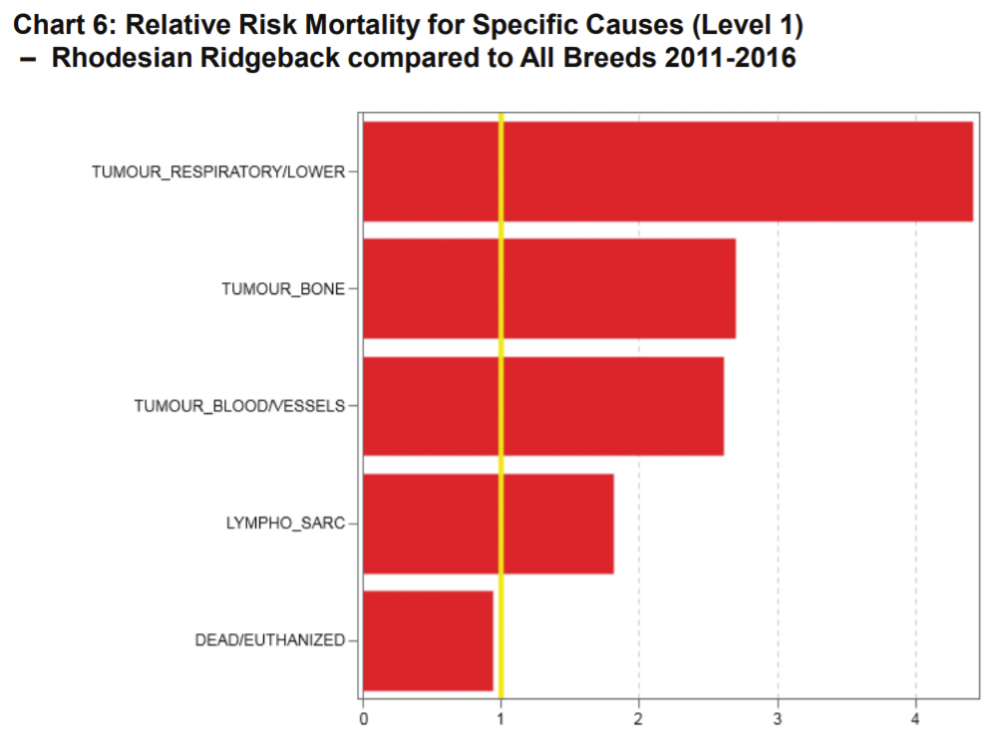
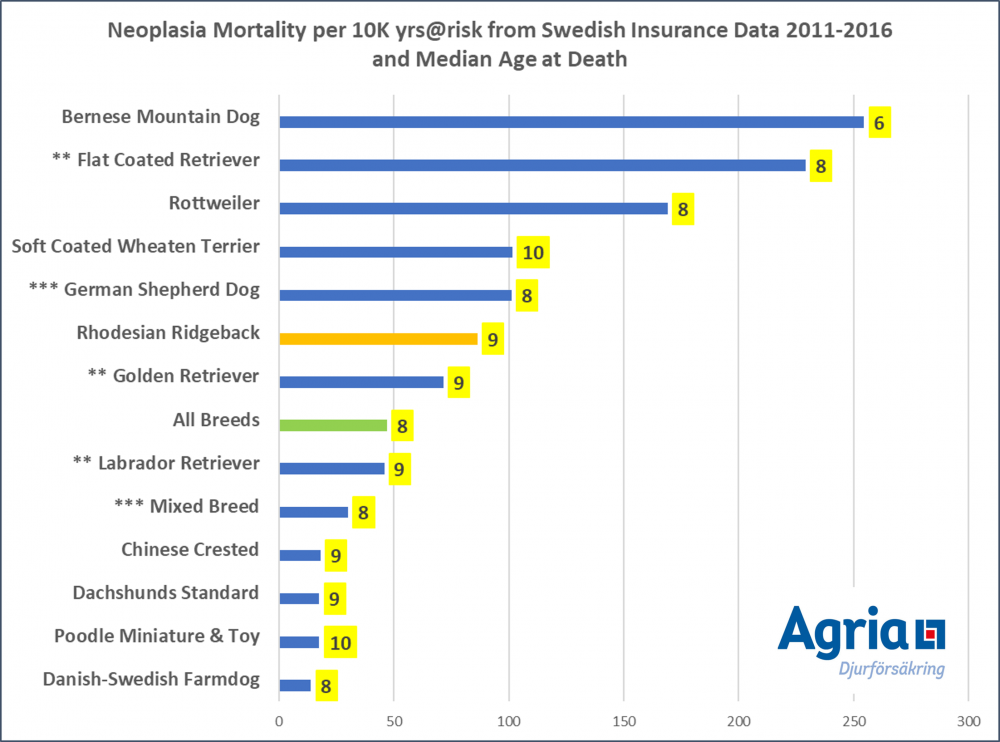
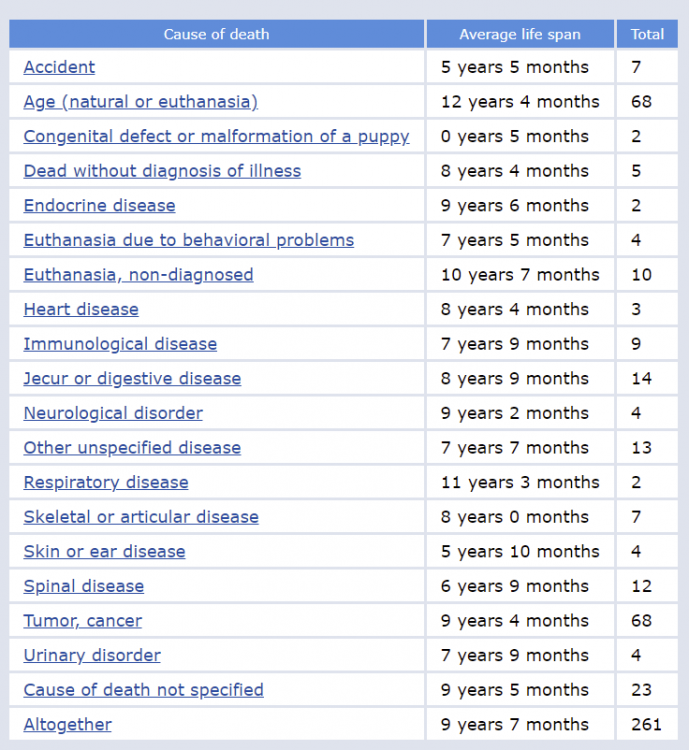
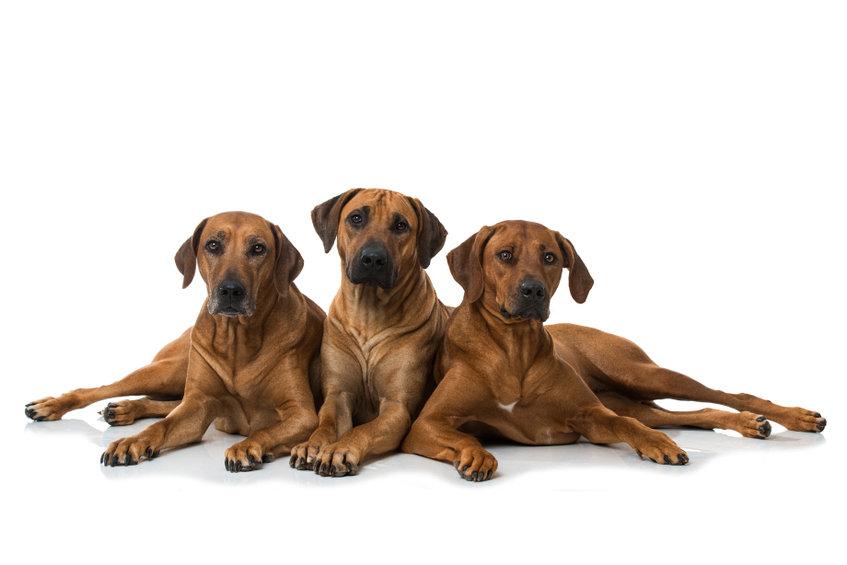
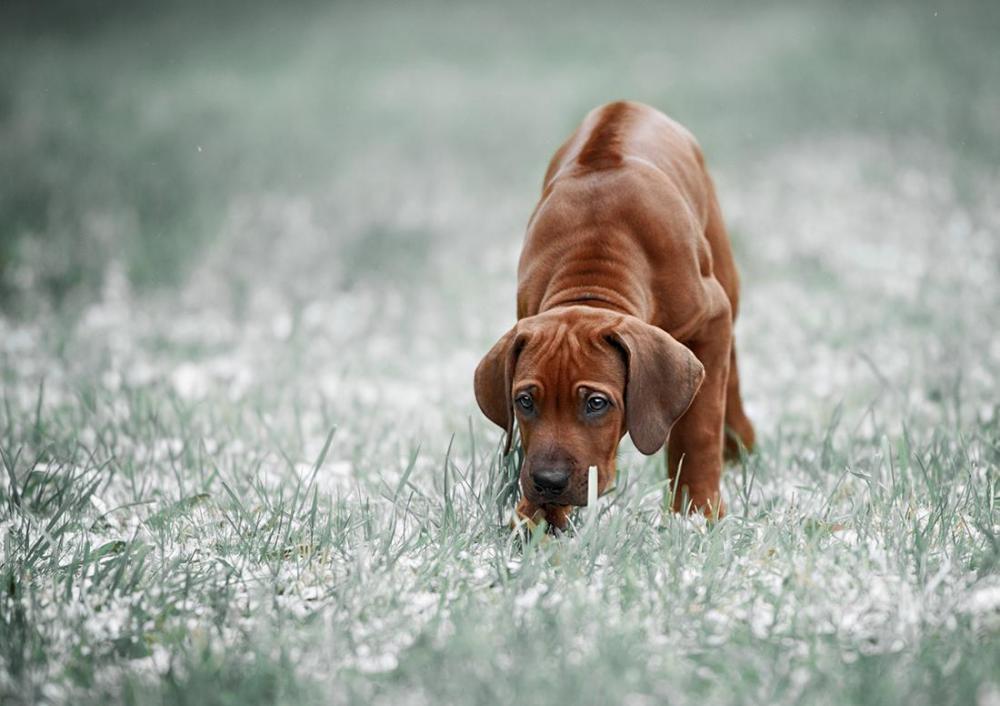
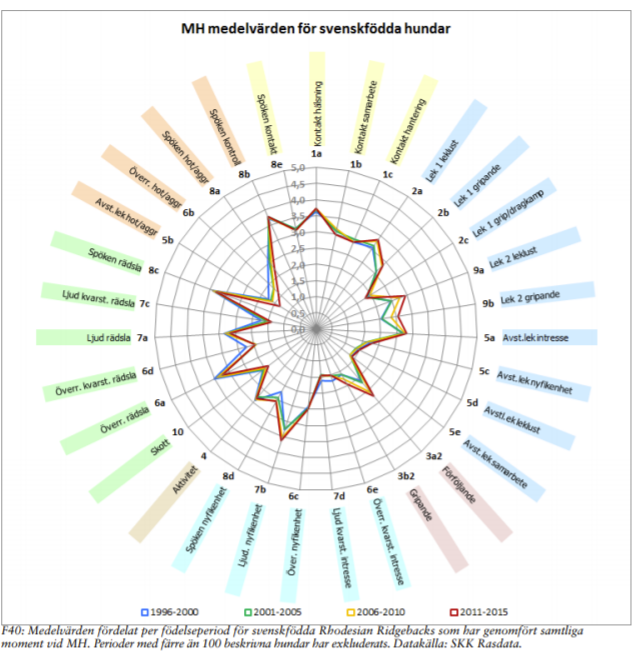

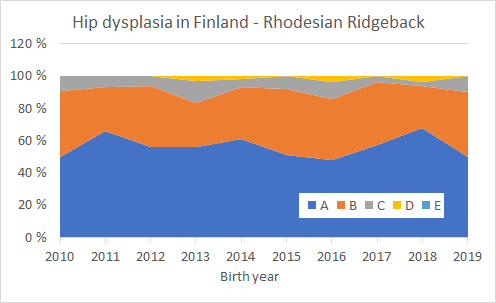 hip dysplasia screening is mandatory for breeding dogs, in order to get the litter registered by the kennel club. Minimum age for screening is 18 months. Grade C (mild dysplasia) is allowed, but only if the mating partner has grade A (normal). Frequencies in Finland: 91 % healthy/borderline (A/B); 51 % screened.
hip dysplasia screening is mandatory for breeding dogs, in order to get the litter registered by the kennel club. Minimum age for screening is 18 months. Grade C (mild dysplasia) is allowed, but only if the mating partner has grade A (normal). Frequencies in Finland: 91 % healthy/borderline (A/B); 51 % screened.
 Elbow dysplasia screening mandatory for breeding dogs, in order to get the litter registered by the kennel club. Finland: minimum age for screening is 18 months. Grades 0-1 are allowed, but grade 1 only if the mating partner has grade 0. Finland: 90 % healthy/borderline (0); 51 % screened.
Elbow dysplasia screening mandatory for breeding dogs, in order to get the litter registered by the kennel club. Finland: minimum age for screening is 18 months. Grades 0-1 are allowed, but grade 1 only if the mating partner has grade 0. Finland: 90 % healthy/borderline (0); 51 % screened.
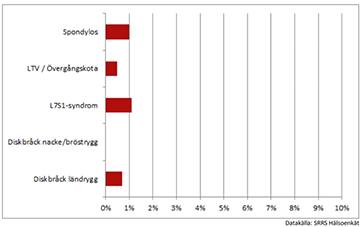 Lumbosacral transitional vertebra (LTV) and spondylosis
Lumbosacral transitional vertebra (LTV) and spondylosis
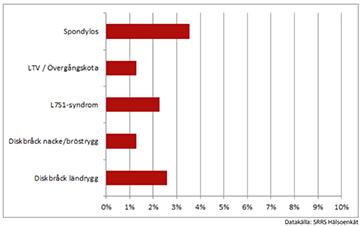
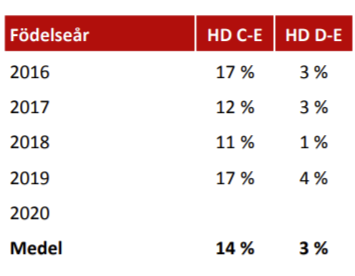 (and Norway): the breed clubs' puppy referral rules require screening and the status A or B (normal or borderline) in order for the litter to be allowed in the list/reference. Sweden (Födelseår = Birth year, C = mild hip dysplasia, D = moderate, E = severe, Medel = Average)
(and Norway): the breed clubs' puppy referral rules require screening and the status A or B (normal or borderline) in order for the litter to be allowed in the list/reference. Sweden (Födelseår = Birth year, C = mild hip dysplasia, D = moderate, E = severe, Medel = Average)
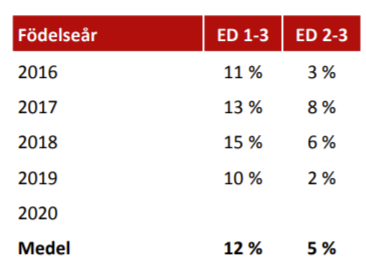 Frequencies in Sweden
Frequencies in Sweden

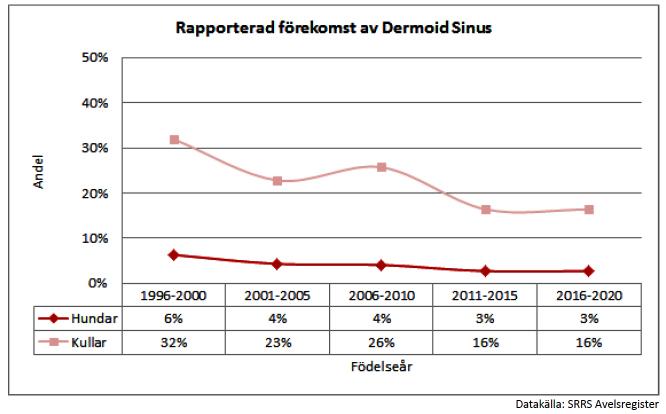
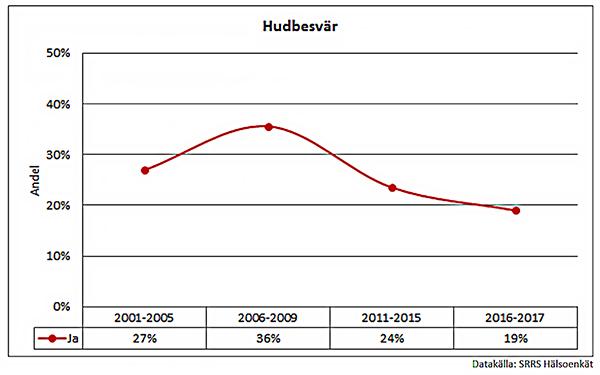
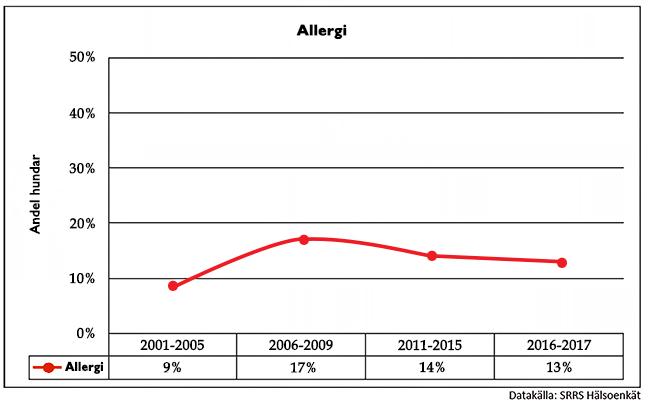
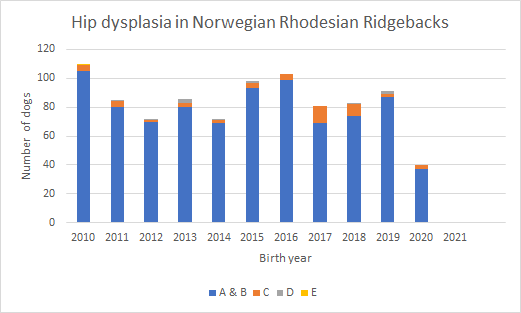 the breed club's puppy referral rules requires screening and the status A or B (normal or borderline) in order for the litter to be allowed in the list/reference.
the breed club's puppy referral rules requires screening and the status A or B (normal or borderline) in order for the litter to be allowed in the list/reference.
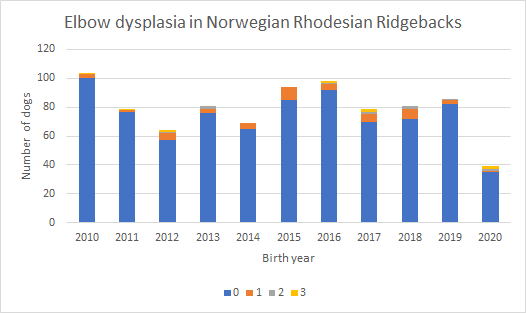 the breed club's puppy referral rules require that the status is 0 (healthy/borderline) in order for the litter to be allowed in the list/reference.
the breed club's puppy referral rules require that the status is 0 (healthy/borderline) in order for the litter to be allowed in the list/reference.

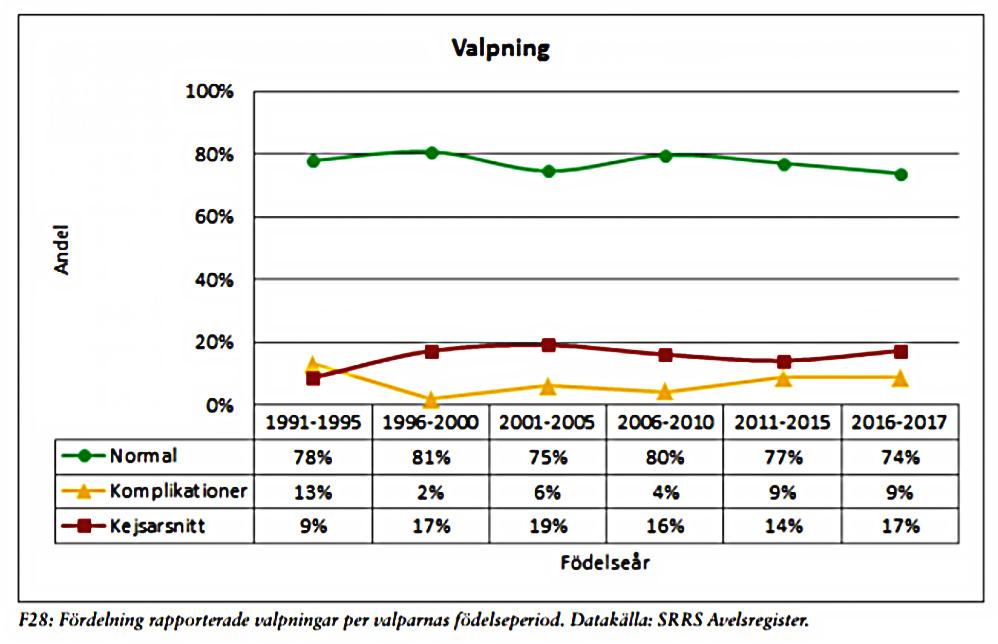 Reproduction is usually unproblematic. Recommended minimum age at mating:
Reproduction is usually unproblematic. Recommended minimum age at mating:
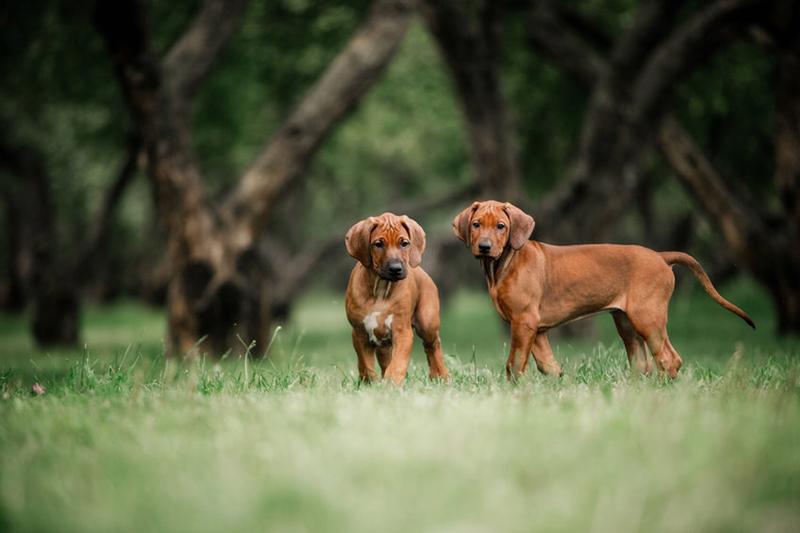
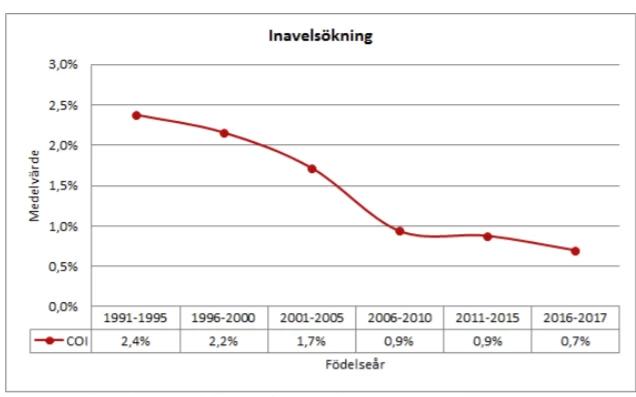


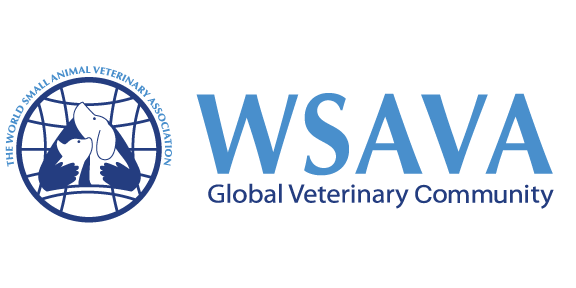
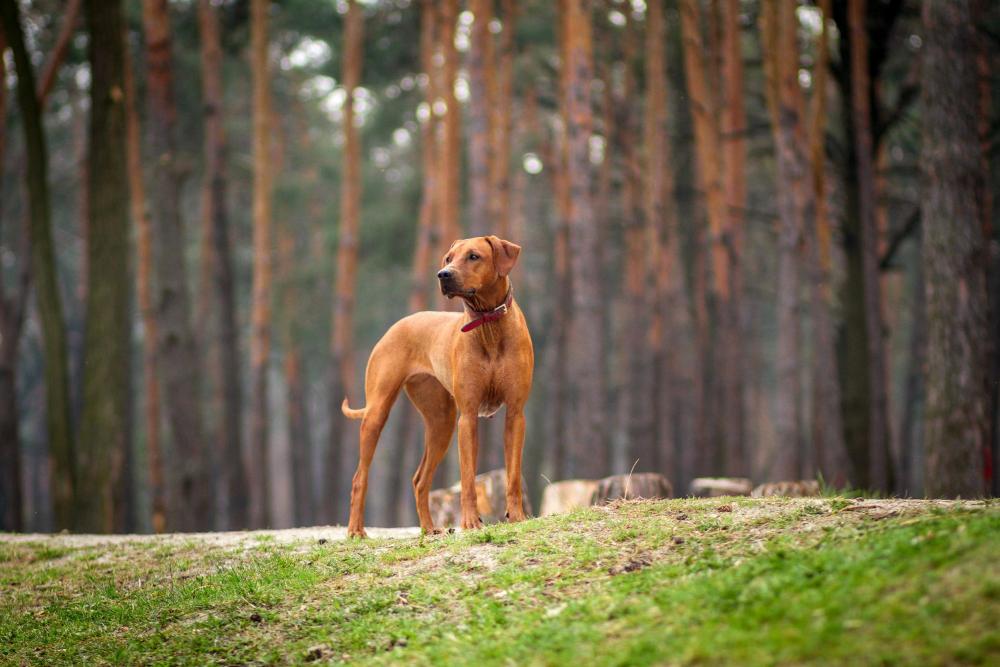
Recommended Comments
There are no comments to display.
Join the conversation
You can post now and register later. If you have an account, sign in now to post with your account.
Note: Your post will require moderator approval before it will be visible.